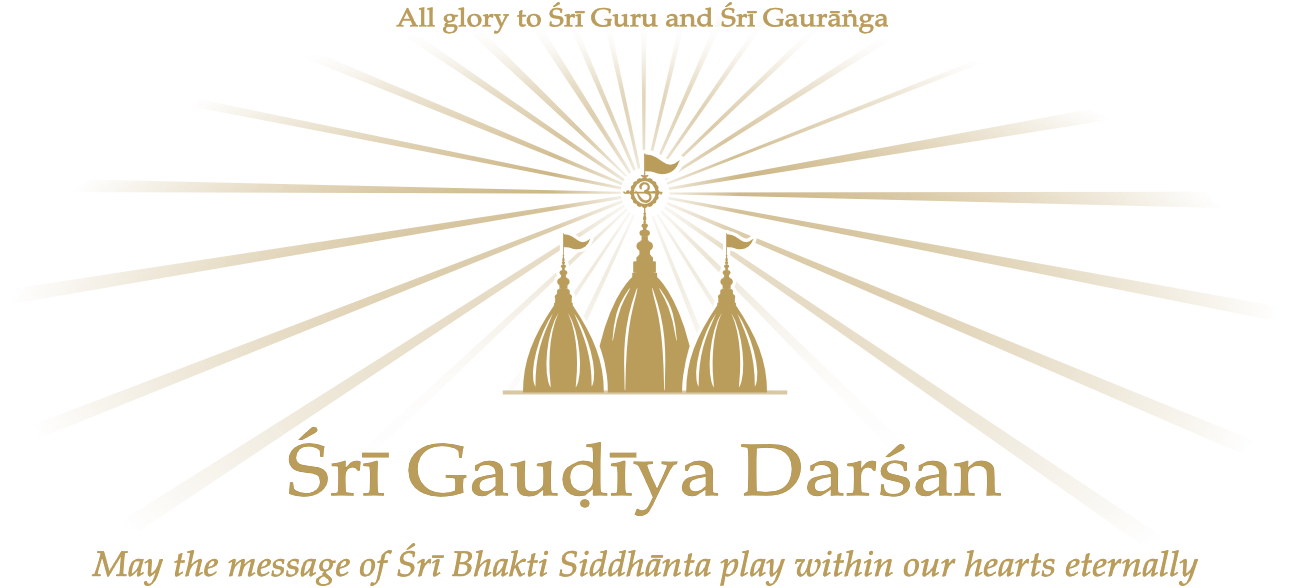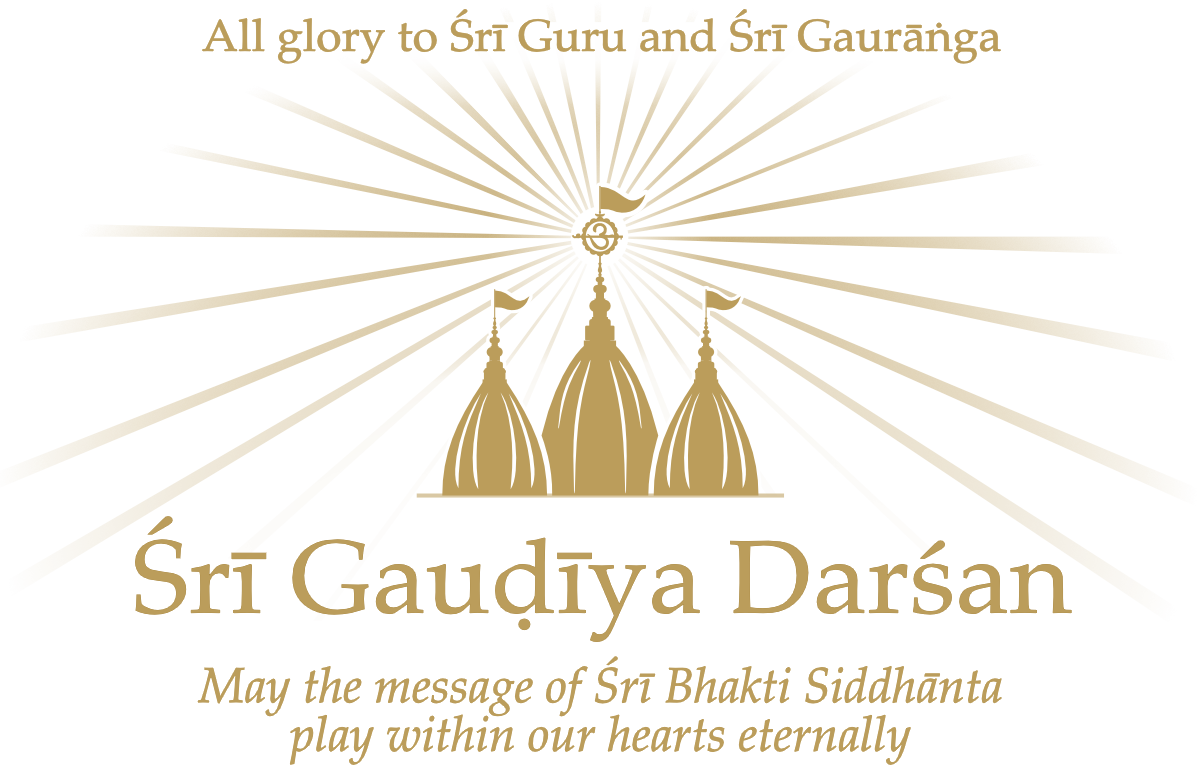Śrīla Bhakti Sundar Govinda Dev-Goswāmī Mahārāj explains how the practitioner presents themselves for service each day.
There is a mantra from self-meditation. I think anyone who has received second initiation knows this mantra.
divyaṁ śrī-hari-mandirāḍhya-tilakaṁ kaṇṭhaṁ sumālānvitaṁ
vakṣaḥ śrī-hari-nāma-varṇa-subhagaṁ śrī-khaṇḍa-liptaṁ punaḥ
pūtaṁ sūkṣma-navāmbaraṁ vimalatāṁ nityaṁ vahantīṁ tanuṁ
dhyāyech chhrī-guru-pāda-padma-nikaṭe sevotsukañ chātmanaḥ
We are meditating on this mantram until we attain the position it describes. When we reach that position, then it is no longer necessary to meditate on the mantram, but until we reach that position, we are meditating on it. This is theory and practice.
Divyaṁ Śrī-Hari-mandirāḍhya-tilakaṁ: my form is decorated with tilak in the twelve places on the body that we conceive of as Temples of the Lord.
lalāṭe keśavaṁ dhyāyen nārāyaṇam athodare
vakṣaḥ-sthale mādhavaṁ tu govindaṁ kaṇṭha-kūpake
viṣṇuñ cha dakṣiṇe kukṣau bāhau cha madhusūdanam
trivikramaṁ kandhare tu vāmanaṁ vāma-pārśvake
śrīdharaṁ vāma-bāhau tu hṛṣīkeśaṁ tu kandhare
pṛṣṭhe tu padmanābhañ cha kaṭyāṁ dāmodaraṁ nyaset
tat prakṣālana-toyan tu vāsudeveti mūrdhani
The forehead is Keśava’s Temple. The belly is Nārāyaṇ’s Temple. The chest is Mādhava’s Temple. The throat is Govinda’s Temple. The right side is Viṣṇu’s Temple. And so on in this way. We mark with tilak all these Temples of the Lord; the Lord protects our spiritual mood of devotion. Then we wash our hand and wipe it on our head.
Divyaṁ śrī-hari-maṇdirāḍhya-tilakaṁ: all the Temples in the body appear beautiful with tilak on them. Kaṇṭhaṁ sumālānvitam: a tulasī-mālā always lives on my neck. Tulasī is very dear to Kṛṣṇa, and Kṛṣṇa always stays with Tulasī. When I wear a tulasī-mālā, Kṛṣṇa must stay with me. Kṛṣṇa may not like me, but He likes Tulasī. So, I always wear a tulasī-mālā around my neck.
Vakṣaḥ śrī-hari-nāma-varṇa-subhagaṁ śrī-khaṇḍa-liptaṁ punaḥ: my form as a worshipper is decorated with sandalwood paste, and on my chest is written Names of the Lord like ‘Rāma’ and ‘Kṛṣṇa’, according to my desire. Pūtaṁ sūkṣma-navāmbaraṁ: I am wearing the very fine, new, clean cloth.
Vimalatāṁ nityaṁ vahantīṁ tanuṁ: my form is spotless. It is a pure, transcendental, eternal form. My body is not this gross physical body or subtle mental body. Actually, I have a transcendental, conscious body, which is clean and clear. There is nothing bad covering it. It is existing with full consciousness, and it is decorated with tilak, a tulasī-mālā, clean clothes, and other auspicious things.
Dhyāyech chhrī-guru-pāda-padma-nikaṭe sevotsukañ chātmanaḥ: meditating on my form in this way, I pray to my Gurudev, “Please engage me in the service of Kṛṣṇa. I am present here before you. This is my form, and I can now do some service for Kṛṣṇa if you give that service to me.”
This is the feeling within this mantra for meditation. Actually, we cannot see, but Kṛṣṇa can see us. First, this feeling is necessary. We cannot see anything with our mundane eyes, but if our eyes become transcendental, then we can see Kṛṣṇa. Until then, we are presenting ourselves through this mantra. Before we worship the Lord, we meditate on our body in this way, and it is necessary for us to reach that position. That is called sādhana, practising life.
References
divyaṁ śrī-hari-mandirāḍhya-tilakaṁ kaṇṭhaṁ sumālānvitaṁ
vakṣaḥ śrī-hari-nāma-varṇa-subhagaṁ śrī-khaṇḍa-liptaṁ punaḥ
pūtaṁ sūkṣma-navāmbaraṁ vimalatāṁ nityaṁ vahantīṁ tanuṁ
dhyāyech chhrī-guru-pāda-padma-nikaṭe sevotsukañ chātmanaḥ
“Meditate that the Lord’s Temple (one’s body) is decorated with shining tilak, one’s neck bears a beautiful tulasī-mālā, one’s chest is adorned with the Names of Śrī Hari and sandalwood paste, one is wearing fine, new, clean cloth, and in one’s pure, eternal form, one is at the lotus feet of Śrī Guru, eager for service.”
lalāṭe keśavaṁ dhyāyen nārāyaṇam athodare
vakṣaḥ-sthale mādhavaṁ tu govindaṁ kaṇṭha-kūpake
viṣṇuñ cha dakṣiṇe kukṣau bāhau cha madhusūdanam
trivikramaṁ kandhare tu vāmanaṁ vāma-pārśvake
śrīdharaṁ vāma-bāhau tu hṛṣīkeśaṁ tu kandhare
pṛṣṭhe tu padmanābhañ cha kaṭyāṁ dāmodaraṁ nyaset
tat prakṣālana-toyan tu vāsudeveti mūrdhani
“Meditating on Keśava, mark the forehead, on Nārāyaṇ the belly, on Mādhava the chest, on Govinda the thoat, on Viṣṇu the right side, on Madhusūdan the right arm, on Trivikram the right shoulder, on Vāman the left side, on Śrīdhar the left arm, on Hṛṣīkeś the left shoulder, on Padmanābha the upper back, and on Dāmodar the lower back. Meditating on Vāsudev, wipe the water used to wash (the hand) on the top of the head.”



Leave a Reply